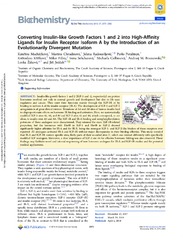Приказ основних података о документу
Converting Insulin-like Growth Factors 1 and 2 into High-Affinity Ligands for Insulin Receptor Isoform A by the Introduction of an Evolutionarily Divergent Mutation
| dc.creator | Machackova, Katerina | |
| dc.creator | Chrudinova, Martina | |
| dc.creator | Radosavljević, Jelena | |
| dc.creator | Potalitsyn, Paulo | |
| dc.creator | Krizkova, Kvetoslava | |
| dc.creator | Fabry, Milan | |
| dc.creator | Selicharova, Irena | |
| dc.creator | Collinsova, Michaela | |
| dc.creator | Brzozowski, Andrzej M. | |
| dc.creator | Zakova, Lenka | |
| dc.creator | Jiracek, Jiri | |
| dc.date.accessioned | 2018-11-22T00:44:00Z | |
| dc.date.available | 2018-11-22T00:44:00Z | |
| dc.date.issued | 2018 | |
| dc.identifier.issn | 0006-2960 | |
| dc.identifier.uri | https://cherry.chem.bg.ac.rs/handle/123456789/2135 | |
| dc.description.abstract | Insulin-like growth factors 1 and 2 (IGF-1 and -2, respectively) are protein hormones involved not only in normal growth and development but also in life span regulation and cancer. They exert their functions mainly through the IGF-1R or by binding to isoform A of the insulin receptor (IR-A). The development of IGF-1 and IGF-2 antagonists is of great clinical interest. Mutations of A4 and A8 sites of human insulin lead to disproportionate effects on hormone IR binding and activation. Here, we systematically modified IGF-1 sites 45, 46, and 49 and IGF-2 sites 45 and 48, which correspond, or are close, to insulin sites A4 and A8. The IGF-1R and IR-A binding and autophosphorylation potencies of these analogues were characterized. They retained the main IGF-1R-related properties, but the hormones with His49 in IGF-1 and His48 in IGF-2 showed significantly higher affinities for IR-A and for IR-B, being the strongest IGF-1- and IGF-2-like binders of these receptors ever reported. All analogues activated IR-A and IGF-1R without major discrepancies in their binding affinities. This study revealed that IR-A and IGF-1R contain specific sites, likely parts of their so-called sites 2', which can interact differently with specifically modified IGF analogues. Moreover, a clear importance of IGF-2 site 44 for effective hormone folding was also observed. These findings may facilitate novel and rational engineering of new hormone analogues for IR-A and IGF-1R studies and for potential medical applications. | en |
| dc.publisher | Amer Chemical Soc, Washington | |
| dc.relation | Czech Academy of Sciences [RVO 61388963, 68378050] | |
| dc.relation | Medical Research Council [MR/K000179/1] | |
| dc.relation | Medical Research Council Grant [MR/R009066/1] | |
| dc.relation | Czech Science Foundation [15-19018S] | |
| dc.rights | openAccess | |
| dc.rights.uri | https://creativecommons.org/licenses/by-nc/4.0/ | |
| dc.source | Biochemistry | |
| dc.title | Converting Insulin-like Growth Factors 1 and 2 into High-Affinity Ligands for Insulin Receptor Isoform A by the Introduction of an Evolutionarily Divergent Mutation | en |
| dc.type | article | |
| dc.rights.license | BY-NC | |
| dcterms.abstract | Мацхацкова, Катерина; Цхрудинова, Мартина; Поталитсyн, Пауло; Кризкова, Кветослава; Фабрy, Милан; Селицхарова, Ирена; Јирацек, Јири; Радосављевић, Јелена; Цоллинсова, Мицхаела; Закова, Ленка; Брзозоwски, Aндрзеј М.; | |
| dc.citation.volume | 57 | |
| dc.citation.issue | 16 | |
| dc.citation.spage | 2373 | |
| dc.citation.epage | 2382 | |
| dc.identifier.wos | 000431088300011 | |
| dc.identifier.doi | 10.1021/acs.biochem.7b01260 | |
| dc.citation.other | 57(16): 2373-2382 | |
| dc.citation.rank | M22 | |
| dc.identifier.pmid | 29608283 | |
| dc.description.other | Supplementary material: [http://cherry.chem.bg.ac.rs/handle/123456789/3185] | |
| dc.type.version | publishedVersion | |
| dc.identifier.scopus | 2-s2.0-85045898101 | |
| dc.identifier.fulltext | https://cherry.chem.bg.ac.rs/bitstream/id/9151/2133.pdf |


